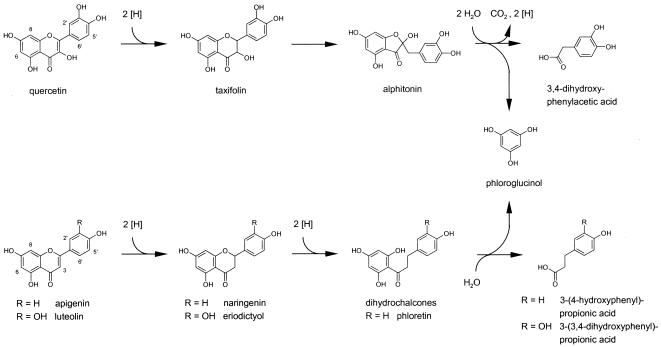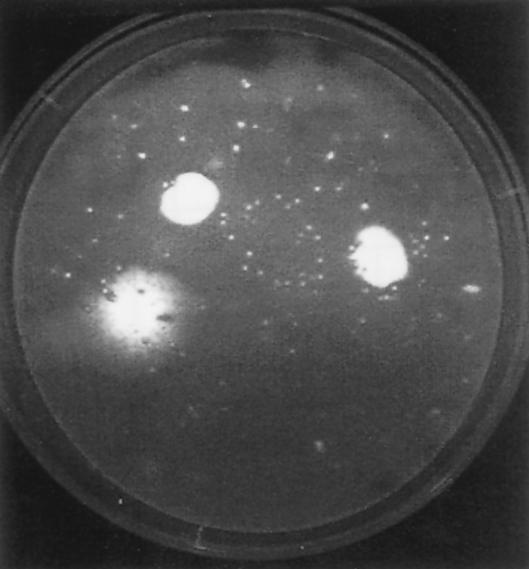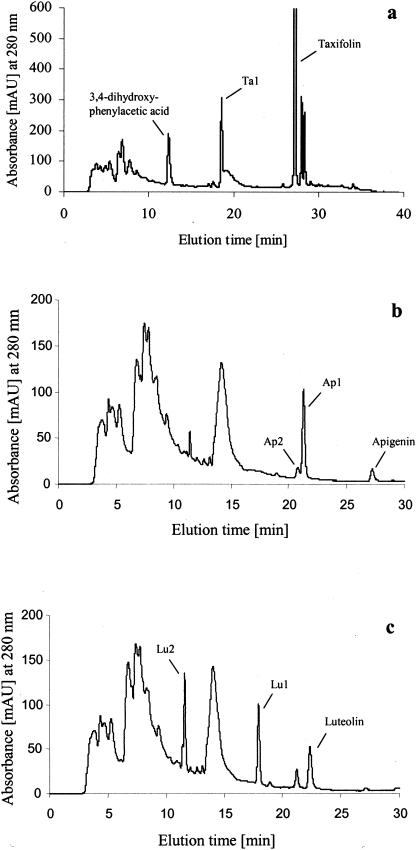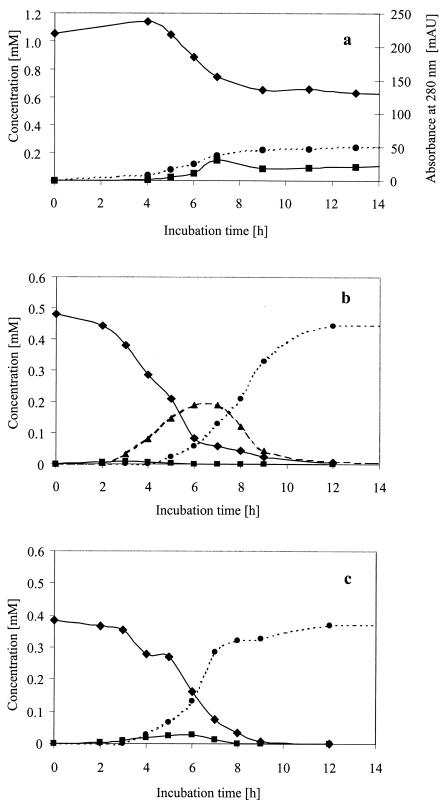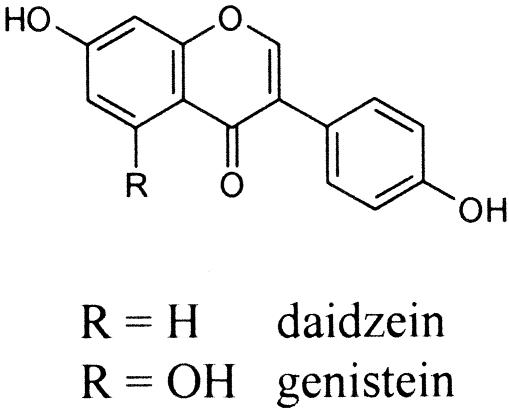Abstract
An anaerobic, quercetin-degrading bacterium was isolated from human feces and identified as Clostridium orbiscindens by comparative 16S rRNA gene sequence analysis. The organism was tested for its ability to transform several flavonoids. The isolated C. orbiscindens strain converted quercetin and taxifolin to 3,4-dihydroxyphenylacetic acid; luteolin and eriodictyol to 3-(3,4-dihydroxyphenyl)propionic acid; and apigenin, naringenin, and phloretin to 3-(4-hydroxyphenyl)propionic acid, respectively. Genistein and daidzein were not utilized. The glycosidic bonds of luteolin-3-glucoside, luteolin-5-glucoside, naringenin-7-neohesperidoside (naringin), quercetin-3-glucoside, quercetin-3-rutinoside (rutin), and phloretin-2′-glucoside were not cleaved. Based on the intermediates and products detected, pathways for the degradation of the flavonol quercetin and the flavones apigenin and luteolin are proposed. To investigate the numerical importance of C. orbiscindens in the human intestinal tract, a species-specific oligonucleotide probe was designed and tested for its specificity. Application of the probe to fecal samples from 10 human subjects proved the presence of C. orbiscindens in 8 out of the 10 samples tested. The numbers ranged from 1.87 × 108 to 2.50 × 109 cells g of fecal dry mass−1, corresponding to a mean count of 4.40 × 108 cells g of dry feces−1.
Flavonoids are widely distributed in plants and are ingested in considerable amounts with food. More than 5,000 different naturally occurring flavonoids have been described so far. They have been proposed to have beneficial effects on human health based on their anti-inflammatory, antioxidant, vasodilatory, anticancerigenic, and antibacterial properties (for reviews, see references 3, 12, and 21). Although it is known that human intestinal bacteria play a significant role in the degradation of flavonoids (22), there is a paucity of information on the species involved, their distribution in humans, and the mechanisms of degradation. So far, Clostridium scindens (30), Clostridium orbiscindens (30, 31), Eubacterium desmolans (30), and Eubacterium ramulus (24), all isolated from human fecal samples, are known to convert flavonoids. However, only E. ramulus (24) was further characterized with respect to its potential to degrade flavonoids, the pathways of conversion of flavonoids, and the organism's distribution in humans.
In this study, quercetin-degrading fecal isolates were identified as C. orbiscindens, whose ability to degrade flavonoids was first described by Winter et al. (30, 31) but not analyzed in detail. Therefore, the C. orbiscindens strains isolated were tested for their range of flavonoids converted and the degradation pathways that were employed. Population levels of C. orbiscindens in 10 human subjects were determined.
MATERIALS AND METHODS
Media and growth conditions.
For cultivation of C. orbiscindens strains I1 to I6, which were isolated in our study, the anoxic techniques of Hungate (14) and Bryant (7) were applied. Cultures were grown under strictly anoxic conditions in 16-ml tubes and were fitted with butyl rubber stoppers and screw caps. The tubes contained 10-ml Wilkens-Chalgren anaerobe (WCA) broth (Oxoid, Basingstoke, United Kingdom). The cultures were incubated overnight at 37°C under a gas phase of N2 and CO2 (80:20, vol/vol). For cultivation on plates, WCA agar (Oxoid) was used. Plating of the cells was carried out in an anaerobic cabinet (model MK 3; DW Scientific, Shipley, United Kingdom), and the plates were incubated in anaerobic jars (Merck, Darmstadt, Germany) at 37°C for 48 h.
Chemicals.
The flavonoids and their respective glycosides were purchased from Roth (Karlsruhe, Germany), except for genistein and daidzein, which were obtained from Acros Organics (Geel, Belgium). Phloroglucinol, 3,4-dihydroxyphenylacetic acid, 3-(3,4-dihydroxyphenyl)propionic acid, 3-(4-hydroxyphenyl)propionic acid, and 1,6-diphenyl-1,3,5-hexatriene were purchased from Fluka (Deisenhofen, Germany).
Isolation of quercetin-degrading bacteria.
For the isolation of quercetin-degrading bacteria, the fluorescence-quenching test (26) was applied. A fecal sample from a healthy male adult was serially diluted in Soerensen buffer (25 mM KH2PO4, 33 mM Na2HPO4, 0.04% [vol/vol] thioglycolic acid, 0.06% [wt/vol] cysteine [pH 6.8]) under anoxic conditions. Circular nylon membranes (82-mm diameter; Roche Diagnostics GmbH, Mannheim, Germany) were soaked in a mixture of 350 μl of 1 mM 1,6-diphenyl-1,3,5-hexatriene (DPH) and 350 μl of 20 mM quercetin and transferred onto WCA agar plates. One hundred microliters each of the dilutions from 10−7 to 10−9 were streaked on the membranes, and the membranes were incubated under anoxic conditions at 37°C for 48 h. Five plates were inoculated for each dilution. For detection of fluorescence, the plates were inspected with a UV lamp (wavelength, 365 nm; BioMérieux, Nürtingen, Germany).
Degradation experiments.
The degradation experiments were carried out in 16-ml tubes fitted with butyl rubber stoppers. The tubes contained 9.8 ml of WCA broth and a gas phase of N2 and CO2 (80:20, vol/vol). An aliquot of 100 μl from a stock solution of luteolin-3-glucoside, luteolin-5-glucoside, naringenin-7-neohesperidoside (naringin), quercetin-3-glucoside, quercetin-3-rutinoside (rutin), phloretin-2′-glucoside, luteolin, apigenin, eriodictyol, naringenin, genistein, daidzein (all at 50 mM concentrations), quercetin, taxifolin (both at concentrations of 50 and 100 mM), or phloretin (10 to 60 mM in 5 mM steps) in dimethyl sulfoxide was added to the medium under anoxic conditions. The media were inoculated with 100 μl of an exponentially growing culture of C. orbiscindens and incubated at 37°C. Samples of 400 μl were taken immediately after inoculation, hourly from 2 to 12 h and at 24 and 48 h. The samples were centrifuged at 12,000 × g for 5 min, and 100 μl of the supernatant was subjected to high-performance liquid chromatography (HPLC) analysis. The pellets were each dissolved in 400 μl of methanol to analyze flavonoids and their products that precipitated in the pellets. The resulting solutions were centrifuged at 12,000 × g for 5 min, and 100 μl of the supernatant was analyzed by HPLC.
HPLC.
The flavonoids and their aromatic degradation products were determined by HPLC in the reversed-phase mode according to the method of Braune et al. (5). Methanol and 2% aqueous acetic acid served as the mobile phase and were used to form gradients as follows: from 5 to 30% methanol in 20 min, from 30 to 50% methanol in 5 min, from 50 to 65% methanol in 5 min, 65% methanol maintained for 5 min, and from 65 to 100% methanol in 7 min. The flow rate was 0.8 ml min−1. For analysis of the apigenin and luteolin degradation and the separation of naringenin and phloretin, the above-mentioned conditions and the following gradients were applied: from 5 to 50% methanol in 10 min and from 50 to 60% methanol in 20 min, followed by 2 min at 100% methanol.
The intermediates and products observed in the flavonoid degradation experiments were identified by their retention times and their UV spectra in comparison to those of reference substances by using HPLC with a UV diode array detector.
Identification of bacterial isolates.
The six isolates I1 to I6 were identified by comparative 16S rRNA gene sequence analysis. The analyses were performed in the laboratory of M. D. Collins, University of Reading, as follows. The 16S rRNA genes of the isolates were amplified by PCR as described by Hutson et al. (15). The PCR products were purified using a Prep-A-Gene kit (Bio-Rad, Hercules, Calif.) according to the manufacturer's instructions. They were directly sequenced using a Taq DyeDeoxy terminator cycle sequencing kit (Applied Biosystems, Foster City, Calif.) and an automatic DNA sequencer (model 373 A; Applied Biosystems). The closest known relatives of the isolates were determined by searching the EMBL and GenBank databases with the FASTA program of the Genetics Computer Group package (9).
Design and validation of a species-specific oligonucleotide probe.
An oligonucleotide probe (S-S-C.orb-0179-a-A-18 [hereinafter abbreviated to C.orb0179]) targeting a hypervariable region of the 16S rRNA from C. orbiscindens was designed by using the Arb software package (29), the Check-Probe function of the Ribosomal Database Project software package (18), and the EMBL database. Table 1 depicts an alignment of probe C.orb0179 and the 16S rRNA target sequences of C. orbiscindens and related organisms. The dissociation temperature of C.orb0179, determined according to the method of de los Reyes et al. (8), was 48°C.
TABLE 1.
Aligned sequences of the oligonucleotide probe C.orb0179 and the 16S rRNA sequences of C. orbiscindens and phylogenetically related organisms
| Probe or organism | Sequencea |
|---|---|
| C.orb0179 | 3′ TACTACGTCAACCCAGCG 5′ |
| Clostridium orbiscindens | 5′ AUGAUGCAGUUGGGUCGC 3′ |
| Eubacterium plautii | 5′ ....A............. 3′ |
| Acanthamoeba castellanii | 5′ ..C.G.....G......U 3′ |
| Clostridium viride | 5′ ........ACG..A.... 3′ |
| Streptococcus sp. | 5′ .A......A...CA.... 3′ |
| Streptococcus anginosus | 5′ .A......A...CA.N.. 3′ |
Nucleotides different from those of the target sequence are shown. N, nucleotide not determined.
C.orb0179 was checked for its specificity towards the target organism by whole-cell in situ hybridization with the target organism and 100 intestinal strains of human or animal origin (28). All bacterial species used for specificity testing were grown at 37°C under strictly anoxic conditions in a complex medium with N2 and CO2 (80:20, vol/vol) as the gas phase or on Columbia blood agar plates (BioMérieux) in anoxic jars. For whole-cell in situ hybridization, the bacteria were fixed as described by Roller et al. (20) and Amann et al. (1). The fixed bacteria were hybridized on silanized, Teflon-coated microscopic slides with probes whose 5′ ends were labeled with Cy3 according to the procedures of Roller et al. (20) and Schwiertz et al. (28). As a positive control, an equimolar mixture of five Bacteria-specific probes (Eub338, Eub785, Eub927, Eub1055, and Eub1088) (16) was used. The fluorescing cells were viewed with either an Optiphot-2 (Nikon, Düsseldorf, Germany) or an Axioplan-2 (Zeiss, Jena, Germany) microscope equipped with filters for epifluorescence microscopy.
Quantification of C. orbiscindens organisms in fecal samples.
To determine the occurrence of C. orbiscindens in humans, C.orb0179 was applied to fecal samples. Fresh fecal samples were collected and fixed according to the method of Schwiertz et al. (28) from 10 healthy volunteers of both sexes aged 31 to 57 years who consumed a Western diet and had not received antibiotics for at least 6 months prior to the study. The cells detected with the C.orb0179 probe were enumerated and related to the bacteria detected with the Bacteria-specific-probe mixture. The cell counts of C. orbiscindens obtained by whole-cell in situ hybridization were compared to the plate counts calculated from the fluorescing colonies identified by the quenching test.
RESULTS AND DISCUSSION
Isolation of quercetin-degrading bacteria.
For the isolation of quercetin-degrading bacteria, the fluorescence-quenching test was applied (26). Agar plates equipped with nylon membranes, quercetin (structure in Fig. 1), and DPH were incubated with dilutions of human feces. After 48 h of incubation at 37°C, the agar plates were observed under UV light. Plates inoculated with fecal dilutions of 10−8 and 10−9 showed several fluorescing spots with a diameter of approximately 1 cm (Fig. 2). Although no distinct colonies were observed within these fluorescing zones, bacteria could be isolated as follows. The centers (5 by 5 mm) of the fluorescing areas were cut out of the filter with a sterile scalpel under anoxic conditions and transferred to WCA broth. The steps comprising the spreading of cells on plates with nylon membranes, the excision of the centers of the fluorescing areas, and the transfer of the excised filter pieces to WCA broth were repeated until the isolates were pure cultures. Six isolates were obtained by this procedure.
FIG. 1.
Pathways of quercetin, apigenin, and luteolin degradation by C. orbiscindens.
FIG. 2.
Human fecal dilution (10−8) spread out on an agar plate prepared to perform the fluorescence-quenching test. The fluorescing zones result from the bacterial degradation of quercetin, which quenches the fluorescence of a fluorescent additive. Some of the small colonies show weak autofluorescence.
Identification of the isolates.
All six isolates (I1 to I6) formed white colonies on WCA agar. The rod-shaped bacteria (1 to 2 μm in length) stained gram positive and formed short chains. They were strictly anaerobic and formed subterminal spores. The identification was accomplished by comparative 16S rRNA gene sequence analysis in which four of the unknown isolates displayed 100% similarity and two of the isolates showed 99% similarity to the 16S rRNA gene sequence of C. orbiscindens (DSM 6740). The phenotypic properties of the isolates mentioned above were in good agreement with the description of this species by Winter et al. (31).
Degradation of quercetin by C. orbiscindens.
The degradation experiments were carried out with C. orbiscindens strain I2. Growing cells of C. orbiscindens I2 converted 0.5 mM quercetin in 6 h completely to a single product (Qu1) (data not shown). The retention time of Qu1 in HPLC analysis was 12.3 min, and the UV spectrum revealed maxima at 237.8 and 286.0 nm. By comparison with the commercially available standard, the compound was identified as 3,4-dihydroxyphenylacetic acid. At a concentration of 1 mM, taxifolin (structure in Fig. 1), an intermediate in quercetin degradation by E. ramulus (5), was degraded to 3,4-dihydroxyphenylacetic acid and an additional compound (Ta1) (Fig. 3a). Ta1 had a retention time of 18.6 min and a UV spectrum with maxima at 235.6 and 295.0 nm. It was identified as alphitonin (structure in Fig. 1) by comparison with the pure substance. Since alphitonin is not commercially available, the purified intermediate of taxifolin degradation by E. ramulus, identified previously by nuclear magnetic resonance analysis as alphitonin (5), was used as the reference. Alphitonin was not detected during the transformation of 0.5 or 1 mM quercetin. The time course of the degradation of 1 mM taxifolin is shown in Fig. 4a. At a concentration of 0.5 mM, taxifolin was completely transformed within 5 h to 3,4-dihydroxyphenylacetic acid but alphitonin was not detected.
FIG. 3.
HPLC elution profile of the supernatant of growing C. orbiscindens cultures incubated under anoxic conditions for 22 h with 1 mM taxifolin and Ta1 (alphitonin) (a); for 3 h with 0.5 mM apigenin, Ap1 (phloretin), and Ap2 (naringenin) (b); and for 6 h with 0.5 mM luteolin, Lu1 (eriodictyol), and Lu2 [3-(3,4-dihydroxyphenyl)propionic acid] (c). mAU, milli-absorbance units.
FIG. 4.
Time course of flavonoid conversion by C. orbiscindens during growth in WCA broth. (a) Concentrations of taxifolin (♦), alphitonin (▪), and 3,4-dihydroxyphenylacetic acid (•). Absorbances at 280 nm indicate concentrations of alphitonin. mAU, milli-absorbance units. (b) Concentrations of apigenin (♦), phloretin (▴), naringenin (▪), and 3-(4-hydroxyphenyl)propionic acid (•). (c) Concentrations of luteolin (♦), eriodictyol (▪), and 3-(3,4-dihydroxyphenyl)propionic acid (•).
C. orbiscindens was isolated by Winter et al. (30, 31) and was reported to be capable of flavonoid ring cleavage. However, Winter et al.'s investigations on flavonoid degradation were limited to identifying the end products of the degradation of quercetin, kaempferol, and naringenin as 3,4-dihydroxyphenylacetic acid, 4-hydroxyphenylacetic acid, and phenylacetic acid, respectively (30). Our investigations described here revealed that C. orbiscindens I2 apparently follows the same pathway for the degradation of quercetin as that described for E. ramulus (5). The initial reduction of the double bond in the 2,3 position of quercetin results in the formation of taxifolin (Fig. 1). The following ring contraction to the identified isomeric alphitonin probably occurs by a ring-opening recyclization mechanism via a chalcone or diketone structure. This reaction may either be catalyzed enzymatically or take place spontaneously. The ring contraction to alphitonin leads to a benzylic CH2 group, which finally occurs in 3,4-dihydroxyphenylacetic acid. The hydrolytic opening of the five-membered ring of alphitonin leads to the formation of phoroglucinol and 3,4-dihydroxyphenylpyruvic acid (unpublished results). The ensuing steps, which yield 3,4-dihydroxyphenylacetic acid, are postulated to follow the well-known reactions of the bacterial phenylpyruvic acid breakdown in the course of phenylalanine degradation (11, 25).
Degradation of apigenin and luteolin by C. orbiscindens.
Growing cells of C. orbiscindens I2 converted a 0.5 mM concentration of the flavone apigenin (structure in Fig. 1) to two intermediates, Ap1 and Ap2, with retention times of 21.3 and 20.8 min, respectively (Fig. 3b), and a final product with a retention time of 13.9 min (Ap3), detected by HPLC analysis after 5 h of incubation. The time course of apigenin degradation is depicted in Fig. 4b. Ap1 was identified as phloretin (structure in Fig. 1) by comparison of its retention time and UV spectrum (maxima at 234.6 and 294.7 nm) with those of the commercially available standard. Comparison of the retention time of Ap2 with that of the reference compound revealed that it is identical to naringenin (structure in Fig. 1). Using the same procedure, Ap3 was identified as 3-(4-hydroxyphenyl)propionic acid. Ap3 and the corresponding standard had identical UV spectra, with maxima at 234.5 and 281.6 nm.
Growing cells of C. orbiscindens converted 0.5 mM naringenin to 3-(4-hydroxyphenyl)propionic acid. Phloretin was degraded to the same end product but only at substrate concentrations of <0.3 mM. Higher concentrations of phloretin inhibited the growth of C. orbiscindens I2.
The conversion of luteolin (0.5 mM) (structure in Fig. 1) yielded one intermediate with a retention time of 18.0 min (Lu1) and an end product with a retention time of 11.6 min (Lu2) (Fig. 3c). The time course of luteolin degradation is shown in Fig. 4c. Comparison of retention times and UV spectra of Lu1 with maxima at 234.9 and 293.9 nm and of Lu2 with maxima at 236.9 and 286.0 nm with those of the commercially available standards led to their identification as eriodictyol (structure in Fig. 1) and 3-(3,4-dihydroxyphenyl)propionic acid, respectively.
Growing C. orbiscindens cultures also converted 0.5 mM eriodictyol to 3-(3,4-dihydroxyphenyl)propionic acid. Phloroglucinol, a proposed intermediate in flavone and flavonol degradation by E. ramulus (24), was shown to be degraded by growing cells of C. orbiscindens within 7 h of incubation.
The resulting intermediates and products observed in flavone transformation by C. orbiscindens support the hypothetical degradation pathway of flavones described for E. ramulus (5, 23). Presumably, the double bond in the 2,3 position of the aglycon is reduced in a first step to a flavanone as shown in Fig. 1. Subsequently, an isomerization to the corresponding chalcone structure takes place. The chalcone is reduced to a dihydrochalcone, and this compound is hydrolyzed to phloroglucinol and a phenylpropionic acid derivative. Phloroglucinol is further degraded to acetate and butyrate.
Although the degradation of flavones and flavonols seems to follow the same pathways in C. orbiscindens and E. ramulus, there are some important differences. While no intermediates could be detected during flavonoid transformation by growing cells of E. ramulus (23), several intermediates accumulated under similar conditions in experiments with C. orbiscindens. Another peculiarity of flavonoid degradation by C. orbiscindens could give some hints as to why bacteria degrade flavonoids at all. Apart from using flavonoids as electron acceptors or to gain additional energy from the degradation of phloroglucinol (6, 17), bacteria may have to detoxify these compounds. Phloretin, for example, inhibited the growth of C. orbiscindens at higher concentrations and may therefore be toxic to the organism. Apparently, the phloretin hydrolase, which catalyzes the cleavage of phloretin to 3-(4-hydroxyphenyl)propionic acid and phloroglucinol (unpublished results), is the bottleneck in the transformation of the flavone apigenin, as phloretin accumulated to comparatively high concentrations in the medium. This accumulation may be due to a very low phloretin hydrolase activity in C. orbiscindens and may also explain the growth inhibition by phloretin. C. orbiscindens may not be able to detoxify the compound in time, in contrast to E. ramulus, which was not inhibited at higher concentrations of phloretin (23). Antibacterial effects of flavonoids have been observed previously. Quercetin, myricetin, and morin inhibit the growth of Bacillus cereus, Bacillus subtilis, Bacillus mycoides, and Staphylococcus aureus (10). More recently, several bacterial strains were tested for their sensitivity to various flavonoids. The tested flavonoids showed antibacterial activity, but the intensity of the inhibitory effect was variable and dependent on the bacterial strain tested. Apigenin, for example, inhibited the growth of Pseudomonas mirabilis, Pseudomonas aeruginosa, Salmonella enterica serovar Typhi, Escherichia coli, Enterobacter aerogenes, Enterobacter cloacae, and Klebsiella pneumoniae (2).
Degradation of flavonoid glycosides and isoflavones by C. orbiscindens.
C. orbiscindens I2 did not convert flavonoid glycosides such as luteolin-3-glucoside, luteolin-5-glucoside, naringenin-7-neohesperidoside (naringin), quercetin-3-glucoside, quercetin-3-rutinoside (rutin), and phloretin-2′-glucoside. This fact is not surprising, as C. orbiscindens has already been described by Winter et al. as an asaccharolytic organism (30, 31). Therefore, C. orbiscindens is dependent on the deglycosylating activities of human tissues such as the small intestine and liver (19) and bacteria such as E. ramulus, Enterococcus casseliflavus (24), and Bacteroides sp. (4) for flavonoid degradation. In contrast to E. ramulus, Enterococcus cassiflavus and Bacteroides sp. deglycosylate the flavonoid only to take advantage of the sugar moieties. The aglycon is not used any further by these species and becomes available for organisms such as C. orbiscindens.
C. orbiscindens I2 also did not degrade the isoflavones daidzein and genistein (Fig. 5). In contrast, E. ramulus wK1 is able to convert the two isoflavones (27). It can therefore be deduced that the enzymes involved in isoflavone transformation are different from the ones involved in flavone or flavonol degradation.
FIG. 5.
Structures of daidzein and genistein.
Prevalence of C. orbiscindens.
The species-specific probe C.orb0179 was developed and applied to human fecal samples in order to estimate the prevalence of C. orbiscindens in the human intestinal tract. C. orbiscindens was detected in the feces of 8 out of the 10 subjects tested. The cell numbers ranged from 1.87 × 108 to 2.50 × 109 cells g of dry feces−1, corresponding to a mean count of 4.40 × 108 cells g of dry feces−1. Total numbers of bacterial cells detected by whole-cell in situ hybridization using the Bacteria-specific probe mixture were in the range of 3.80 × 1011 to 1.27 × 1012 cells g of dry feces−1. The numbers determined for C. orbiscindens are equivalent to 0.12% of the total number of fecal bacteria.
For comparison, dilutions of a fecal sample were spread on agar plates with quercetin-containing membranes prepared for the quenching test. The fluorescent spots considered as resulting from quercetin degraders were enumerated. The mean count was 5.1 × 108 cells g of wet feces−1. Taking a factor of 3 for the conversion of wet weight to dry weight, the calculated number of 1.5 × 109 cells g of dry feces−1 is within the range of cell counts determined by whole-cell in situ hybridization in fecal samples of the 10 subjects described above. Since all quercetin-degrading clones isolated from the plates were identified as C. orbiscindens, it might be concluded that all C. orbiscindens cells detected by whole-cell in situ hybridization are capable of quercetin degradation.
In parallel, the cell counts of E. ramulus were determined with whole-cell in situ hybridization of the same set of fecal samples (13). E. ramulus was detected in the feces of 6 out of 10 subjects at a mean concentration of 3.16 × 108 cells g of dry feces−1. These numbers account for 0.04% of all fecal bacteria and are comparable to the cell counts of C. orbiscindens determined herein. Considering all these results together, C. orbiscindens may be as important as E. ramulus for flavonoid degradation in the human intestinal tract.
Acknowledgments
This work was supported by the Deutsche Forschungsgemeinschaft (grants INK 26/A1-1 and INK 26/B1-1). This work was carried out with financial support from the Commission of the European Communities, specific RTD program “Quality of Life and Management of Living Resources,” QLK1-2000-108, “Microbe Diagnostics.” It does not necessarily reflect the Commission’s views and in no way anticipates the Commission’s future policy in this area.
We are grateful to Matthew D. Collins (School of Food Biosciences, University of Reading) for sequencing of the 16S rRNA genes of the isolated strains.
REFERENCES
- 1.Amann, R. I., W. Ludwig, and K.-H. Schleifer. 1995. Phylogenetic identification and in situ detection of individual microbial cells without cultivation. Microbiol. Rev. 59:143-169. [DOI] [PMC free article] [PubMed] [Google Scholar]
- 2.Basile, A., S. Giordano, J. A. Lopez-Saez, and R. C. Cobianchi. 1999. Antibacterial activity of pure flavonoids isolated from mosses. Phytochemistry 52:1479-1482. [DOI] [PubMed] [Google Scholar]
- 3.Birt, D. F., S. Hendrich, and W. Wang. 2001. Dietary agents in cancer prevention: flavonoids and isoflavonoids. Pharmacol. Ther. 90:157-177. [DOI] [PubMed] [Google Scholar]
- 4.Bokkenheuser, V. D., C. H. Shackleton, and J. Winter. 1987. Hydrolysis of dietary flavonoid glycosides by strains of intestinal Bacteroides from humans. Biochem. J. 248:953-956. [DOI] [PMC free article] [PubMed] [Google Scholar]
- 5.Braune, A., M. Gutschow, W. Engst, and M. Blaut. 2001. Degradation of quercetin and luteolin by Eubacterium ramulus. Appl. Environ. Microbiol. 67:5558-5567. [DOI] [PMC free article] [PubMed] [Google Scholar]
- 6.Brune, A., and B. Schink. 1992. Phloroglucinol pathway in the strictly anaerobic Pelobacter acidigallici: fermentation of trihydroxybenzenes to acetate via triacetic acid. Arch. Microbiol. 157:417-424. [Google Scholar]
- 7.Bryant, M. P. 1972. Commentary on the Hungate technique for culture of anaerobic bacteria. Am. J. Clin. Nutr. 25:1324-1328. [DOI] [PubMed] [Google Scholar]
- 8.de los Reyes, F. L., W. Ritter, and L. Raskin. 1997. Group-specific small-subunit rRNA hybridization probes to characterize filamentous foaming in activated sludge systems. Appl. Environ. Microbiol. 63:1107-1117. [DOI] [PMC free article] [PubMed] [Google Scholar]
- 9.Devereux, J., P. Haeberli, and O. Smithies. 1984. A comprehensive set of sequence analysis programs for the VAX. Nucleic Acids Res. 12:387-395. [DOI] [PMC free article] [PubMed] [Google Scholar]
- 10.el-Gammal, A. A., and R. M. Mansour. 1986. Antimicrobial activities of some flavonoid compounds. Zentbl. Mikrobiol. 141:561-565. [DOI] [PubMed] [Google Scholar]
- 11.Fujioka, M., Y. Morino, and H. Wada. 1970. Metabolism of phenylalanine (Achromobacter eurydice). Methods Enzymol. 17A:585-596. [Google Scholar]
- 12.Harborne, J. B., and C. A. Williams. 2000. Advances in flavonoid research since 1992. Phytochemistry 55:481-504. [DOI] [PubMed] [Google Scholar]
- 13.Hold, G. L., A. Schwiertz, R. I. Aminov, M. Blaut, and H. J. Flint. 2003. Oligonucleotide probes that detect quantitatively significant groups of butyrate-producing bacteria in human feces. Appl. Environ. Microbiol. 69:4320-4324. [DOI] [PMC free article] [PubMed] [Google Scholar]
- 14.Hungate, R. E. 1969. A role tube method for cultivation of strict anaerobes. Methods Microbiol. 3B:117-132. [Google Scholar]
- 15.Hutson, R. A., D. E. Thompson, and M. D. Collins. 1993. Genetic interrelationships of saccharolytic Clostridium botulinum types B, E and F and related clostridia as revealed by small-subunit rRNA gene sequences. FEMS Microbiol. Lett. 108:103-110. [DOI] [PubMed] [Google Scholar]
- 16.Kleessen, B., J. Noack, and M. Blaut. 1999. Distribution of viable and non-viable bacteria in the gastrointestinal tract of gnotobiotic and conventional rats. Microb. Ecol. Health Dis. 11:218-225. [Google Scholar]
- 17.Krumholz, L. R., R. L. Crawford, M. E. Hemling, and M. P. Bryant. 1987. Metabolism of gallate and phloroglucinol in Eubacterium oxidoreducens via 3-hydroxy-5-oxohexanoate. J. Bacteriol. 169:1886-1890. [DOI] [PMC free article] [PubMed] [Google Scholar]
- 18.Maidak, B. L., J. R. Cole, T. G. Lilburn, C. T. Parker, Jr., P. R. Saxman, R. J. Farris, G. M. Garrity, G. J. Olsen, T. M. Schmidt, and J. M. Tiedje. 2001. The RDP-II (Ribosomal Database Project). Nucleic Acids Res. 29:173-174. [DOI] [PMC free article] [PubMed] [Google Scholar]
- 19.Németh, K., G. W. Plumb, J. G. Berrin, N. Juge, R. Jacob, H. Y. Naim, G. Williamson, D. M. Swallow, and P. A. Kroon. 2003. Deglycosylation by small intestinal epithelial cell β-glucosidases is a critical step in the absorption and metabolism of dietary flavonoid glycosides in humans. Eur. J. Nutr. 42: 29-42. [DOI] [PubMed] [Google Scholar]
- 20.Roller, C., M. Wagner, R. Amann, W. Ludwig, and K. H. Schleifer. 1994. In situ probing of gram-positive bacteria with high DNA G + C content using 23S rRNA-targeted oligonucleotides. Microbiology 140:2849-2858. [DOI] [PubMed] [Google Scholar]
- 21.Ross, J. A., and C. M. Kasum. 2002. Dietary flavonoids: bioavailability, metabolic effects, and safety. Annu. Rev. Nutr. 22: 19-34. [DOI] [PubMed] [Google Scholar]
- 22.Scalbert, A., and G. Williamson. 2000. Dietary intake and bioavailability of polyphenols. J. Nutr. 130:2073-2085. [DOI] [PubMed] [Google Scholar]
- 23.Schneider, H., and M. Blaut. 2000. Anaerobic degradation of flavonoids by Eubacterium ramulus. Arch. Microbiol. 173:71-75. [DOI] [PubMed] [Google Scholar]
- 24.Schneider, H., A. Schwiertz, M. D. Collins, and M. Blaut. 1999. Anaerobic transformation of quercetin-3-glucoside by bacteria from the human intestinal tract. Arch. Microbiol. 171:81-91. [DOI] [PubMed] [Google Scholar]
- 25.Schneider, S., M. E. Mohamed, and G. Fuchs. 1997. Anaerobic metabolism of l-phenylalanine via benzoyl-CoA in the denitrifying bacterium Thauera aromatica. Arch. Microbiol. 168:310-320. [DOI] [PubMed] [Google Scholar]
- 26.Schoefer, L., A. Braune, and M. Blaut. 2001. A fluorescence-quenching test for the detection of flavonoid transformation. FEMS Microbiol. Lett. 204:277-280. [DOI] [PubMed] [Google Scholar]
- 27.Schoefer, L., R. Mohan, A. Braune, M. Birringer, and M. Blaut. 2002. Anaerobic C-ring cleavage of genistein and daidzein by Eubacterium ramulus. FEMS Microbiol. Lett. 208:197-202. [DOI] [PubMed] [Google Scholar]
- 28.Schwiertz, A., G. Le Blay, and M. Blaut. 2000. Quantification of different Eubacterium spp. in human fecal samples with species-specific 16S rRNA-targeted oligonucleotide probes. Appl. Environ. Microbiol. 66:375-382. [DOI] [PMC free article] [PubMed] [Google Scholar]
- 29.Strunk, O., and W. Ludwig. 1996. A software environment for sequence data. Technische Universität München, Munich, Germany.
- 30.Winter, J., L. H. Moore, V. R. Dowell, Jr., and V. D. Bokkenheuser. 1989. C-ring cleavage of flavonoids by human intestinal bacteria. Appl. Environ. Microbiol. 55:1203-1208. [DOI] [PMC free article] [PubMed] [Google Scholar]
- 31.Winter, J., M. R. Popoff, P. Grimont, and V. D. Bokkenheuser. 1991. Clostridium orbiscindens sp. nov., a human intestinal bacterium capable of cleaving the flavonoid C-ring. Int. J. Syst. Bacteriol. 41:355-357. [DOI] [PubMed] [Google Scholar]



